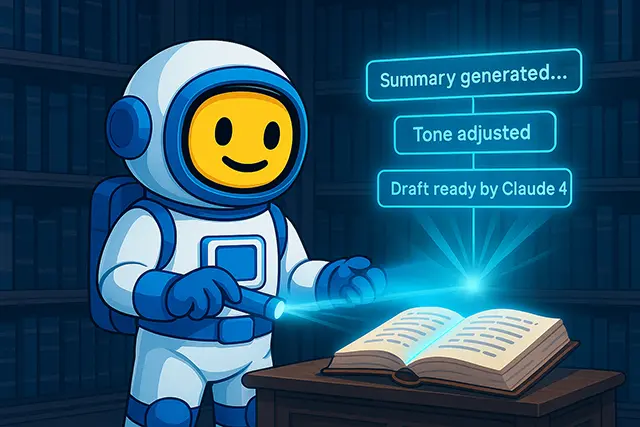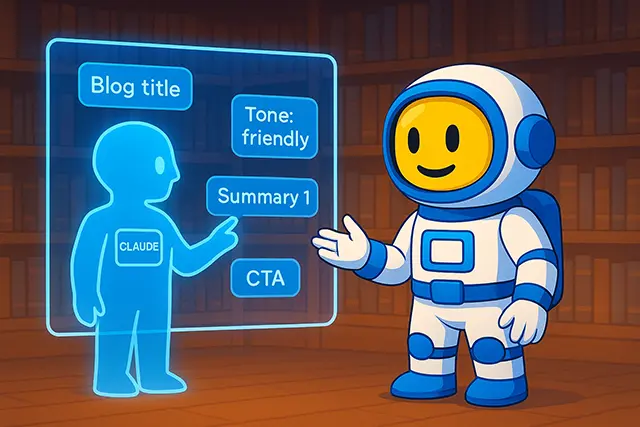Claude 4 for Writers: Summarization, Tone Control, and Ideation

Claude 4 for Writers is transforming the way content professionals approach modern writing tasks. Writers today don’t just write they organize information, adjust tone across platforms, brainstorm under pressure, and rework drafts to meet brand guidelines. And with content demand rising across industries from SaaS to lifestyle productivity matters more than ever. That’s where Claude 4 comes in: not to replace writers, but to help them work faster, smarter, and more consistently.
Claude 4, developed by Anthropic, is a next-generation large language model designed not only to generate text but to support human creativity in safe, scalable, and controllable ways. Unlike older models that simply spit out paragraphs, Claude 4 assists writers with structure, alignment, and tone precision. As discussed in our deep dive into Claude 4 by Anthropic, its foundation in Constitutional AI makes it one of the most trusted LLMs for editorial and marketing professionals.
This article explores how writers from solo content creators to large editorial departments are using Claude 4 to streamline their creative workflows. Whether you’re drafting SEO articles, rewriting product pages, or brainstorming newsletter headlines, Claude 4 feels more like a thoughtful collaborator than a faceless tool.
Table of Contents
How Claude 4 Helps Writers Do More With Less
Writers in modern content teams are expected to do more than write they research, repurpose, ideate, and adapt copy across formats and audiences. Claude 4 meets those demands with tools for structure, tone, ideation, and alignment.
From summarization tools for content creators to AI tone control for marketing teams, Claude 4 is redefining how writers use large language models in their day-to-day work.
Long-Form Summarization Without Losing Meaning
One of the most time-consuming parts of writing isn’t writing it’s reading. Writers often spend hours digesting research, transcripts, reports, or interview notes before they even start drafting. Claude 4 reduces that burden by summarizing long content into tight, usable briefs that preserve nuance and intent.
For instance, a journalist working with a 10-page research report can prompt Claude: “Summarize this study for an article targeting policymakers.” Within seconds, the model produces a paragraph that hits key findings without misrepresenting the source. A content strategist might feed Claude several client blog posts and ask it to extract themes for competitor analysis.
Thanks to Claude’s expanded token window allowing over 100,000 tokens of input writers no longer need to split their sources. As highlighted in our Claude 4 vs GPT-4 comparison, this makes Claude ideal for long-form research-heavy workflows.
Claude 4 for Writers – Controlling Tone, Voice, and Readability
One of the most common challenges writers face is tone mismatch. A paragraph that sounds perfect for a startup’s homepage might feel stiff on social media. A technical manual that explains clearly to engineers might alienate everyday users. Claude 4 helps solve this by allowing writers to control tone, voice, and complexity on demand.
Using prompt instructions like “Make this sound more casual” or “Adjust this for an eighth-grade reading level,” writers can reshape drafts for different audiences without having to rewrite from scratch. Claude respects structure and flow, so you don’t get robotic output or weird transitions. More importantly, it doesn’t just imitate tone it aligns with brand-specific language, which is critical for consistency across platforms.
This precision comes from its training methodology. As discussed in our article on Constitutional AI, Claude was taught to follow values like clarity, helpfulness, and harmlessness traits that directly translate to better tone handling for brands. Whether you’re adjusting onboarding copy for a SaaS app or rewriting a product page for an international market, Claude’s tone control allows for fast, flexible editing without compromising message integrity.
Idea Generation and Creative Outlining with Claude 4 for Writers
Staring at a blank page is a universal experience for writers. Claude 4 transforms that moment of dread into an interactive ideation session. Writers can prompt Claude for blog post ideas, newsletter topics, YouTube titles, or even frameworks for whitepapers. And because the model is trained on a wide variety of formats and industries, its suggestions are far from generic.
For example, you might ask, “Give me 10 ideas for a B2B fintech blog targeting small business owners,” and Claude will return focused, on-brand topics with rationale included. You can follow up with, “Give me an outline for the third topic,” and get a structured draft in seconds.
Creative teams use Claude to unblock early-stage ideation and move into execution faster. Editors appreciate that it helps junior writers structure their thoughts, while solo content creators enjoy having a “co-writer” who can help fill in gaps or offer new angles.
This kind of ideation support is also where Claude’s integration with tools like Make.com and Retool becomes powerful, which we’ll touch on in more detail in Claude 4 Tools and Platforms.
Rewriting and Polishing Drafts
Rewriting is an underrated skill. Most drafts are not bad they’re just too long, unclear, or inconsistent. Claude 4 makes the revision process less painful by helping writers tighten up their sentences, reorganize paragraphs, and improve flow without rewriting the voice out of the text.
For example, a content manager might paste a product tutorial that runs too long and prompt Claude: “Cut this by 30% but keep all essential information.” Or a marketing writer might say, “Rewrite this to improve clarity and sentence variety.” Claude doesn’t just apply grammar rules it makes informed edits that reflect editorial best practices.
Compared to GPT-4, which sometimes rephrases too aggressively or adds unintended ideas, Claude’s output is generally more restrained and respectful of the original. As discussed in our side-by-side comparison, Claude’s editing style is ideal for writers who want assistance not automation.
This makes Claude a favorite in industries like journalism, academic writing, and agency workflows, where keeping the writer’s voice intact is just as important as grammar correctness.
Safe and Brand-Safe First Drafts
If you write in industries like healthcare, finance, legal, or education, you know that content safety isn’t just about avoiding bias it’s about ensuring accuracy and avoiding legal risk. Claude 4 is particularly well-suited for these environments because of its alignment-first training.
Writers can safely use Claude for first drafts, confident that it won’t inject profanity, offensive phrasing, or toxic assumptions. Unlike other models that occasionally veer off-topic or invent facts, Claude errs on the side of caution making it easier for editorial teams to review and approve content.
Let’s say you’re drafting copy for a mental health app. You can ask Claude to “Explain mindfulness for teenagers using friendly, supportive language,” and the result will be readable, empathetic, and legally safe. Or you might generate financial blog content for beginners, knowing that Claude won’t insert investment advice or trigger compliance flags.
This is where Claude truly shines for enterprise teams, as we explain more fully in Claude 4 vs Gemini vs GPT-4.
| Feature / Model | Claude 4 | GPT-4 | Gemini 1.5 Pro |
|---|---|---|---|
| Tone Control | Precise, consistent | Variable, depends on temperature | Often neutral, less brand-specific |
| Summarization Quality | High for long input (100K tokens) | Moderate (limited context window) | Moderate-high, less structured |
| Creative Ideation | Strong, structured responses | Broad and varied | Often generic |
| Content Safety | Best-in-class via Constitutional AI | Good, but prone to hallucination | Unpredictable in complex prompts |
| Brand Voice Adaptation | Excellent | Requires fine-tuning | Inconsistent |
Prompt Engineering for Writing Control
The real power of Claude 4 becomes evident when writers learn to guide it precisely. Prompt engineering crafting instructions that produce high-quality, structured results is what separates casual users from professionals.
Editorial teams are now creating prompt templates for common tasks: “Summarize meeting notes for a client-facing email,” “Generate three intro paragraphs for this outline,” or “Rephrase this content for mobile push notifications.” By standardizing these prompts, teams can produce consistent results across content types and writers.
In environments where speed matters but tone must remain constant like social media teams, blog networks, or editorial agencies this approach allows for scale without sacrificing quality. And because Claude 4 is stable across generations, you’re not constantly tweaking outputs like with earlier models.
We go deeper into this methodology in Claude 4 Fine-Tuning and RAG, which shows how to combine Claude’s generation with retrieval techniques and custom training loops.

Real Use Cases of Claude 4 in Editorial Teams
Across industries, editorial teams are already using Claude 4 to upgrade their workflow. A mid-sized content agency uses Claude to repurpose existing blog posts into LinkedIn threads, saving their writers hours per week. A B2B tech publisher generates five headlines for every new article using Claude, then A/B tests them in email campaigns. A legal news outlet uses Claude to summarize court rulings into plain-English briefs for their weekly newsletter.
Even solo newsletter writers are seeing results. One creator prompts Claude to “summarize three trending topics in AI this week” and then builds commentary around those summaries cutting their research time in half while staying fresh and timely.
These aren’t experiments they’re new norms.
Should Writers Rely on Claude 4 Every Day?
The short answer is yes with boundaries. Claude 4 is most effective when treated as a writing partner, not a replacement. Writers who use it to brainstorm, rewrite, and summarize often report faster drafts, clearer content, and fewer revision rounds. But the final judgment style, ethics, story arc still belongs to the human.
When used strategically, Claude doesn’t remove the writer’s voice. It amplifies it. It cuts the mechanical labor of writing repetition, restructuring, checking tone and leaves more room for creativity and insight.
Editorial Workflow with Claude 4
- Prompt Claude to generate topics and title suggestions
- Build an outline based on the selected idea
- Draft the first pass with Claude’s help
- Use Claude to refine tone and readability
- Summarize or document the final version internally
- Conduct final review and publish
It’s the same principle that underlies every great writing tool: the pen helps, but the story comes from the hand that holds it.
Final Thoughts: Claude 4 for Writers Better, Not Just Faster
Claude 4 isn’t a threat to writers it’s a force multiplier. It’s the co-editor who never sleeps, the researcher who doesn’t miss details, the brainstorming partner who never runs out of ideas. For content teams juggling multiple formats, tones, and deadlines, Claude 4 provides a layer of intelligence that doesn’t override creativity it enhances it.
The best writers of the next decade won’t be the ones who ignore AI. They’ll be the ones who learn to wield it skillfully. And with Claude 4, they’ll write better not just faster.



